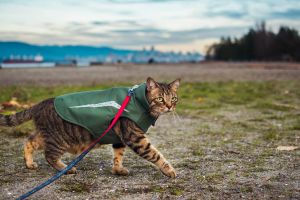
Anyone who has witnessed an indoor cat looking out the window or lying in wait near the front door for any chance to slip outside knows that cats are curious about the outdoors. Mental enrichment can add to an indoor cat’s quality of life, but regardless of how many toys your cat has or how intricate your kitty condo, a trip outside to enjoy the sounds, smells, and sights of nature with you can offer variety and challenge. But how do get you get your cat comfortable with the equipment required and the limitations that can arise by being on a lead?
Here are some tips to help turn this task into a simple and enjoyable way to share the outdoors with your furry feline:

Getting prepared and gathering your supplies is the first step to successful leash training. You will need:
- Cat harness – Cats can easily slip out of their collar, or can get their collar stuck on something while exploring, so you need a cat-specific jacket style harness which evenly distributes the pulling force across a cat’s body, rather than focusing it on a couple of spots like a traditional dog harness. Adjust the fit so it is snug enough not to back out of, or your cat will be gone in a flash.
- Lightweight leash – Choose a non-retractable 4-6 ft. leash for safety, make sure it is properly attached to the harness, and keep the leash end looped around your thumb, with the rest comfortably gathered in your hand.
- Vaccinations – Always keep your cat’s vaccinations current, and let your vet know that your indoor cat will be venturing outside in case they recommend some additional vaccinations
- Microchip – In the unfortunate event your cat escapes their harness and gets lost, it will b easier to bring them home if they are microchipped and you keep the contact information linked to the chip current.
- Cat collar with ID tags – Make sure your cat is wearing a quick release collar when outdoors so they don’t get trapped if it gets snagged on a branch etc. There should be ID on the collar as well.
- Flea and Tick Preventives – Make sure your cat is protected from external parasites all year round, especially if they will be venturing outdoors.
- Treats – Bring along high value treats to reinforce positive behaviors, especially at the beginning of this process
For your cat’s safety, it’s essential to get your cat used to the harness and leash indoors before you attempt anything outdoors.

- Start by leaving the harness out for a day or two so your cat can get used to the sight and smell of this new object
- Place the harness on the cat and adjust for comfort, offering treats to create a positive association. Keep the harness on for longer and longer periods of time. Be sure to supervise your cat while the harness is on — Never leave your cat alone and unattended with the harness on.
- Once your cat is used to the harness, you can attach the leash. You should hold the leash lightly or just let your cat drag it as he or she walks (don’t allow the leash to tighten just yet). Continue to offer treats to entice your cat to walk forward with the leash attached.
- Now you may give the leash a light pull, and then lure your cat forward with a treat for a few steps before offering it. This teaches your cat to walk forward when the leash is pulled.

- Now you’re ready to head outside! Start with an orientation to your back patio or yard. Then, attempt a short trip around the yard. The next step can be to explore the perimeter of your home. Ideally, these first experiences should be low on stimuli, so your cat has a chance to get used to being outdoors. For most people, hanging out in an enclosed yard is enough of an outdoor experience, and it is the safest place to do it. However, if you and your cat are comfortable walking with the leash, you may wish to take a short walk beyond your yard, increasing the duration of the walks gradually.
Safety First!

Remember, walking a cat is not like walking a dog! The pace will be much slower, and your focus will be on observing your cat and following his or her lead. Your cat may decide to sniff grass or plants, meander along an irregular path, or frolic with delight in the open air. No matter what he or she does, stay alert to all behaviors and take any cues of anxiety or stress seriously. Cut it short if these materialize. Always be on guard against a loose dog or other animal, as your cat is very vulnerable. You should always avoid contact with other animals.
Be aware that exposing your cat to the outdoors will likely increase your cat’s desire to be outdoors. You’ll need to take extra precautions whenever you are using doors leading to the outside, to keep your cat from sneaking out on its own.
Cats need enrichment to live full, happy lives. Controlled walks outside are a wonderful way to let them explore and flex those furry wild cat muscles. Just keep in mind the outdoors can be intimidating and overwhelming if you and your cat are not prepared.
Take your time. Do some training for yourself and your cat. Be prepared for anything. But most of all, trust your instincts and enjoy this bonding time with your cat. Listen to what their body language is telling you. They’ll let you know what they’re ready for. And you can follow alongside!






Leave a Reply